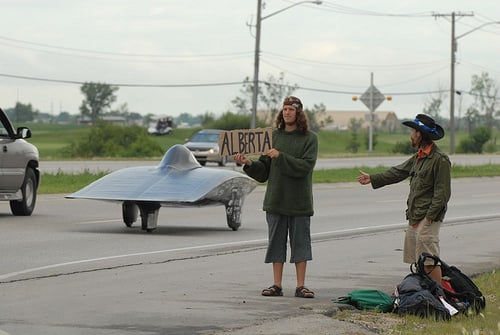
August 6, 2008
The Solar Raceway
Picture this: You’re driving down the highway when in the rearview you spy a soapbox derby car built by college students barreling along at a traffic-friendly speed. The car is smothered in photovoltaics and looks more than a little extraterrestrial. Continuum by the University of Michigan won the 2008 NASC with a time of 51:41:53. […]
Picture this: You’re driving down the highway when in the rearview you spy a soapbox derby car built by college students barreling along at a traffic-friendly speed. The car is smothered in photovoltaics and looks more than a little extraterrestrial.
Continuum by the University of Michigan won the 2008 NASC with a time of 51:41:53.
Chances are you’ve just been witness to the North American Solar Challenge (NASC) which wrapped up a jaw-dropping and exclusively sun-powered 2,400 mile journey from Plano, Texas to Calgary, Alberta on July 23rd. The University of Michigan entry was the first to cross the finish line (their fifth win!), completing the challenge in just over 50 hours. Principia College came in second at just over 60 hours, followed closely by Bochum University of Applied Sciences.
This year Michigan’s vehicle averaged 45 miles per hour. According to Dan Eberle, Director of the American Solar Challenge, when Michigan won the first race in 1990 their average was only 25 miles per hour. Doubling the speed requires eight times as much energy, so it’s a true testimony to a swiftly advancing technology.
Ra 7 by Principia College came in second at 61:38:45.
SolarWorld No. 1 by Bochum University of Applied Sciences was third with a time of 63:47:55.
Eberle says that what Michigan really has going for them is a “dedication to the systems approach.” He compares it to a LEED-rated building where low-flow toilets don’t help all that much if the grey water system doesn’t work—“You don’t design this thing in a vacuum from piecing this and that together. Michigan starts from ground zero and includes everything—the business plan, art plan, engineering, and media—in the whole project.”
Amazingly, in eighteen years of the challenge, no one has been seriously injured, though there are always a few harrowing moments. This year, one team (Eberle wouldn’t say who) left their batteries on a charger too long and started a fire while another car had break failure in traffic and managed to pull through relatively unscathed. These mishaps seem a small price to pay for a bright (and solar) future in transportation.

Hitchhikers try to get in on the solar action.
All photos courtesy: NASC – See more photos at: http://www.americansolarchallenge.org/event/asc2008/blog/media.html






